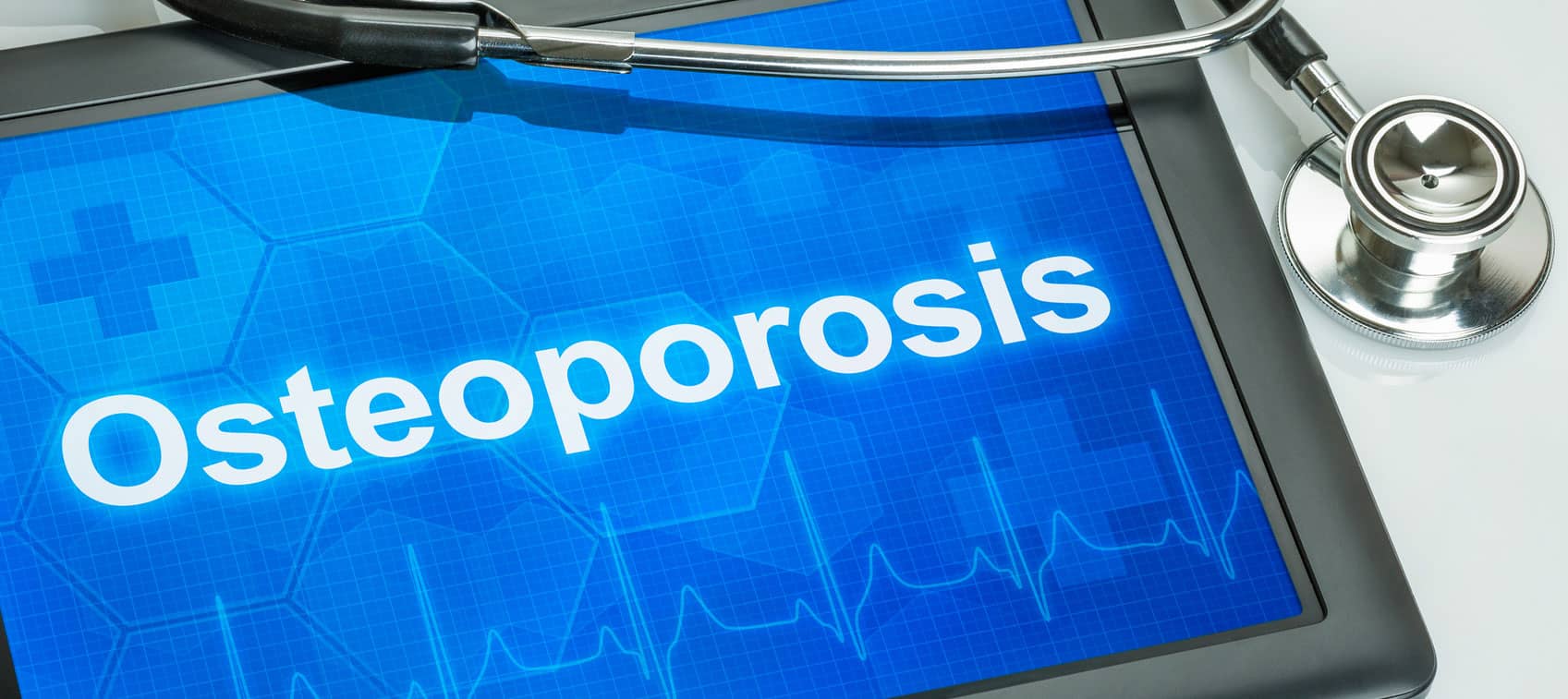
Osteoporosis is a disease that makes a person’s bones weak and more likely to break. According to the National Osteoporosis Foundation, roughly 10 million Americans have osteoporosis and another 44 million have low bone density, placing them at higher risk.
Conventional Treatment Falls Short
Sadly, conventional medicine’s attempt to treat osteoporosis falls short…very short. Other than telling patients to take extra calcium (which is important—but only a small part of a complete treatment plan), the two most common treatments for osteoporosis are hormone replacement therapy and bisphosphonate drugs.
Hormone Replacement
Taking hormone replacement therapy (particularly estrogen) in an effort to treat osteoporosis is equivalent to burning down the barn to get rid of the mice. A greater lifetime exposure to estrogen increases the risk of cancer, but this information has been overshadowed by the fact that estrogen helps to boost the absorption of calcium, which increases bone mass.
Estrogen levels are so closely linked to bone mass that researchers now tell us that they can predict a woman’s cumulative lifetime exposure to estrogen simply by measuring her bone mass. The greater her bone mass, the greater her estrogen exposure. However, the greater her estrogen exposure, the greater her risk of breast cancer, too.
Bisphosphonates
As far as the so-called bone-building bisphosphonates (Fosamax, Boniva, Actonel, and Evista), there are major downsides. These include gastrointestinal side effects and chemical burning of the esophagus (which is why the package inserts instruct patients to sit upright and refrain from eating for half an hour after taking the drug). Other reported side effects include:
- Eye pain and inflammation
- Potentially life-threatening blood calcium deficiencies
- Kidney toxicity
- Osteonecrosis (infection and death of bone tissue in the jaw). Symptoms of this terrifying side effect include jaw pain, loosening teeth, abscesses, and rotting, draining, and exposed jaw bones.
Even more disturbing than these side effects is the fact that bisphosphonate drugs don't actually restore bone by stimulating new bone growth. The marketing language is carefully crafted to skirt this inconvenient truth. Instead, they slow the rate at which old bone is lost by blocking the action of osteoclasts—cells that dismantle old, stressed, or damaged bone so it can be replaced by new tissue, made by other cells called osteoblasts.
This may sound like hair-splitting, but it's not. It means that the bones of a person taking bisphosphonate drugs are increasingly constructed of over-aged, damaged, or "sick" bone cells that have been allowed to linger longer than is good for the skeleton at large.
I advise against both of these controversial and dangerous treatments. There are much safer natural ways to prevent and treat osteoporosis.
Natural Supplements for Osteoporosis
If you have osteoporosis, it's essential that you follow an alkaline diet, get regular exercise, and take a high-quality multivitamin/mineral. For extra support, there are a few key nutrients that are especially important for treating osteoporosis naturally, as well as preventing it.
Calcium
Fermented milk products provide calcium along with lactic acid, which enhances the digestive process. Include yogurt, kefir, buttermilk, acidophilus milk, and cheese in your diet.
I also recommend supplementing with the digestive acid betaine hydrochloride. It will help increase the amount of calcium you assimilate into your system.
As far as calcium supplements go, here are daily dosage recommendations:
- Women in their 30s and 40s, and those on estrogen replacement therapy: at least 1,000 mg
- Postmenopausal women not on estrogen replacement therapy: 1,500 mg daily
- Most men: 1,000–1,200 mg daily
Try to stick to these general dosages because, while too much calcium generally isn't a problem, daily intakes of 2,000 mg or more may cause the parathyroid glands to increase hormone secretion in an effort to lower calcium levels.
Vitamin D
Vitamin D helps the body absorb and use calcium. Low levels of vitamin D are directly related to poor bone strength and growth. An estimated 80 percent of older women worldwide have a vitamin D deficiency.
Direct sunlight is one of the best sources of vitamin D. It really doesn't require that much exposure to reap the benefits. One 20-minute full-body exposure to the summer sun will produce up to 20,000 IU in many people within 48 hours. (Those who have dark skin, are obese, follow vegetarian diets, or use sunscreen or cholesterol-lowering drugs will probably make less.)
However, most of us don’t have the luxury of sunbathing regularly, so supplementation is a necessity. Take 5,000 IU of vitamin D per day, as D3 (cholecalciferol—the more active form of vitamin D).
Strontium
Strontium is a trace mineral generally found along with calcium in foods.
In a three-year study involving 1,649 women, it was found that those taking strontium in addition to calcium and vitamin D increased their spinal bone mass density (BMD) by 11.4 percent, while those on just calcium and vitamin D lost 1.3 percent of their spinal BMD. The group on strontium also had 59 percent fewer fractures during the study period compared to those not taking the mineral supplement.
Other studies have shown that when strontium is taken with calcium and vitamin D, it can improve BMD in the neck of the femur, as well as the spinal vertebra and hip structure.
The above study suggests that a dose of 680 mg of strontium daily seems to provide the best results.
X-Factor
This nutrient helps bones to absorb all the helpful dietary vitamins and minerals. It can be found in X-Factor Gold Concentrated Butter Oil, made by Green Pastures.
The recommended daily dosage is half a teaspoon a day, eaten directly from the jar. Don’t use it in cooking or add it to hot food; the heat will kill the active factors.
X-Factor Gold butter oil contains many of the components of butter, but I still recommend the use of whole butter from grass-fed cows, which has the fat-soluble vitamins A, D, and E, trace minerals, conjugated linolenic acid, and many other bone-friendly nutrients.
Avoid Phosphorus
As important as the mineral phosphorus is to health, too much of it can lead to serious problems. High-phosphorus diets, especially when you’re low in calcium, can lead to osteoporosis.
The way this happens lies in how phosphorous acts on the parathyroid glands. These glands secrete the parathyroid hormone (PTH), which regulates calcium levels in blood and tissues. When calcium levels are low in relation to phosphorous levels, the parathyroid glands produce PTH, which raises calcium levels by leaching it from bones.
Unfortunately, about 70 percent of all dietary phosphorus is readily absorbed and directly transported into the bloodstream. But an easy step that can dramatically reduce phosphorus is to eliminate soft drinks and eat fewer prepared (processed or frozen) foods, all of which are high in this mineral. Focus on fresh, whole foods—and your drink of choice should be good old-fashioned water. Also, you should increase your calcium intake through diet and supplementation.
Vibration Therapy
Bones grow and re-mineralize in response to the forces of stress placed on them. This generally requires that you engage in some type of progressive resistance exercise/weight lifting to keep your bones strong.
However, weight lifting isn’t an option for everyone. Fortunately, “whole body vibration therapy” is a great substitute. (You may recognize this therapy by the name of one of the best known vibration exercise machines, the Power Plate.)
Vibration therapy involves standing on a mechanical vibrating plate. When the plate is adjusted to the right frequency, simply standing on it will cause postural muscles to contract anywhere from 30 to 50 times a second.
As your body ever so slightly shifts back and forth, muscles must contract and relax with each shift. In just 10 minutes, the muscles get a tremendous workout, resulting in increased strength, stability, and tone.
Using vibration therapy just three times a week can lead to dramatic results. Blood flow increases and joints become stronger and more flexible. Studies have also shown that levels of the stress hormone cortisol decrease, while levels of growth hormone and testosterone, which are important for regeneration and repair processes, increase.
If there's any downside to the Power Plate, it's the high cost. However, when it comes to preventing and osteoporosis naturally, I don't know of any exercise besides weight lifting that can achieve similar results.


